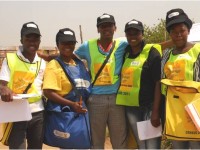Carolina Morgan, Research Associate
I’m writing from Pretoria, South Africa, where I’ve spent the last week visiting small townships in Lesedi Municipality, about an hour and a half away. This trip begins I2UD’s third project with WorleyParsonsRSA, an engineering firm, to help improve South African townships (learn about our past work). Under the current project with Lesedi, we’re helping four townships draft urban design frameworks and identify projects in preparation for their application for the national Neighborhood Development Partnership Grant. This grant funds physical improvements that have social, economic and environmental benefits in ‘disadvantaged’ areas, meaning those that suffered under Apartheid.
We began our site visits in Ratanda, the largest of the four townships. After reviewing Ratanda’s maps and project documents, I had not expected to find such a lively community. It was cheering to see people decorating the façades and front yards of their government-provided houses, groups chatting outside convenience stores, and children walking back from school in their impeccable uniforms. While most people’s basic needs have been met, the township’s economic development has stalled due to the lack of an attractive township center (there are 3 main sections separated by vast tracts of land), too few access roads to nearby cities, and an absence of economic opportunities.
The townships of Kwazenzele and Impumelelo are visibly poorer. In Kwazenzele, many people live in slum-like conditions, and the government has only had funding to deliver one-third of the promised 240 houses. The township has one major road, one soccer field, and two large open spaces that are used only for dumping trash. Impumelelo is a larger township with maze-like roads and hard-to-find entrances and exits. Almost every house here is subletting to another family who sets up a shack in the back yard.
The fourth township we visited, Jameson Park, is strategically located between Heidelberg and Nidel, two of the most important cities in the region, and across from a large future industrial park. Given anticipated changes, Jameson Park hopes to leverage planned growth to meet its development needs and to ensure that its residents are not excluded from economic opportunities.
In talking with communities leaders and municipal officials, I’ve found that these communities lack good infrastructure, economic activity, and connectivity to other urban centers. Yet, despite the range of challenges in the different townships, and even within them, there are great opportunities in each to utilize the national grants. I am returning to Cambridge with over 1,500 photos, a long list of invaluable inputs from the communities themselves, support from the Municipality, and plenty of ideas that we will develop into urban design frameworks and project proposals within the next few months.

